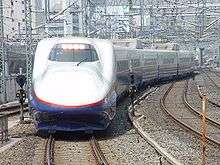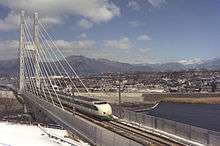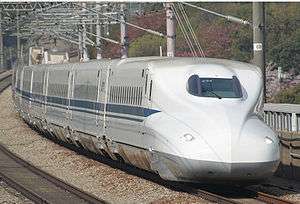Asama (train)
The Asama (あさま) is a high-speed Shinkansen train service operated by East Japan Railway Company (JR East) on the Hokuriku Shinkansen in Japan.[1] The shinkansen service was introduced in October 1997, but the name was first used for a semi-express service operated by Japanese National Railways (JNR) in 1961.[2] "Asama" is the name of an active volcano (Mount Asama) near Karuizawa, on the boundary between Gunma and Nagano Prefecture.
 An E7 series set on an Asama service in April 2014 | |
| Overview | |
|---|---|
| Service type | Shinkansen |
| Status | Operational |
| Locale | Japan |
| First service | 1 March 1961 (Semi-express) 1 October 1997 (Shinkansen) |
| Current operator(s) | JR East |
| Former operator(s) | JNR |
| Route | |
| Start | Tokyo |
| End | Nagano |
| Line(s) used | Hokuriku Shinkansen |
| On-board services | |
| Class(es) | Standard + Green + Gran Class |
| Catering facilities | Trolley service |
| Technical | |
| Rolling stock | E7 series, W7 series |
| Track gauge | 1,435 mm (4 ft 8 1⁄2 in) standard gauge |
| Electrification | 25 kV AC 50/60 Hz overhead |
| Operating speed | 260 km/h (160 mph) |
Operations
All 16 Asama services stopped at Tokyo, Ueno, Ōmiya, Takasaki, Karuizawa, Sakudaira, Ueda, and Nagano. 11 of them made an additional stop at Kumagaya, Honjō-Waseda, and Annaka-Haruna.
Train formations
Asama services are operated using 12-car E7 series or W7 series trainsets formed as shown below, with car 1 at the Tokyo end.[3] Car 11 is a "Green" car, and car 12 is a "Gran Class" car with 2+1 seating. Unlike on Tohoku Shinkansen Hayabusa services, however, a dedicated attendant service is not provided in Gran Class cars on Asama services.[4] All cars are no-smoking.[4]
| Car No. | 1 | 2 | 3 | 4 | 5 | 6 | 7 | 8 | 9 | 10 | 11 | 12 |
|---|---|---|---|---|---|---|---|---|---|---|---|---|
| Class | Non-reserved | Non-reserved | Non-reserved | Non-reserved | Non-reserved | Reserved | Reserved | Reserved | Reserved | Reserved | Green | Gran Class |
| Facilities | Toilets | Toilets, phone | Toilets | Wheelchair space, accessible toilet, phone | Toilets | Wheelchair space, accessible toilet | Toilets |
- Interior of an E7 series Gran Class car 12
 Interior of an E7 series Green car 11
Interior of an E7 series Green car 11- Interior of an E7 series ordinary-class car 10
 An internationally recognizable "No Smoking sign"
An internationally recognizable "No Smoking sign"
Rolling stock
- E7 series 12-car F sets (since 15 March 2014)
- W7 series 12-car W sets (since 14 March 2015)
Services were initially operated using a dedicated fleet of fourteen 8-car E2 series "N" sets based at Nagano Shinkansen Depot.[3] Trains are designed to maintain speeds of 260 km/h (160 mph) on the 30 km continuous gradient of 30‰ between Takasaki and Karuizawa.
New E7 series 12-car sets, also based at Nagano Depot, were introduced on Asama services from the start of the revised timetable on 15 March 2014.[5] These trains include "Gran Class" seating arranged 2+1 abreast. E7 series trainsets were initially used on seven return services daily, with a further four return workings added from 19 April 2014.[5] JR West W7 series 12-car sets, based at Hakusan Depot, were introduced from the start of the revised timetable on 14 March 2015.
 A JR East E7 series trainset on an Asama service in June 2015
A JR East E7 series trainset on an Asama service in June 2015 A JR West W7 series trainset
A JR West W7 series trainset
Previously used
- E2 series 8-car J sets (from October 1997 until 2002)
- E2 series 8-car N sets (from 1 October 1997 until 31 March 2017)
- 200 series 12-car F80 set (February 1998 only)
- E4 series 8-car P50/P80 sets, as Max Asama
 A Nagano Shinkansen E2 series "J" set in February 1998
A Nagano Shinkansen E2 series "J" set in February 1998 JR East E2 series set N12 arriving at Tokyo Station on an Asama service in June 2002
JR East E2 series set N12 arriving at Tokyo Station on an Asama service in June 2002.jpg) An E4 series set
An E4 series set Modified set F80 on a Nagano Shinkansen Asama service in February 1998
Modified set F80 on a Nagano Shinkansen Asama service in February 1998
Pre-shinkansen

- 181 series EMU sets (October 1966–)
- 189 series EMU 9/11/12-car sets (October 1975–September 1997)
- 489 series EMU sets
History
Semi-express Asama
The name Asama was first introduced on 1 March 1961 for semi-express (準急, junkyū) services operating between Nagano and Niigata. This service operated until 30 November 1962, after which the train was renamed Akakura (赤倉). From 1 December 1962, the name was used for the semi-express services operating between Ueno in Tokyo and Nagano on the Shinetsu Line. This service continued until 30 September 1963, after which the train was renamed Maruike (丸池).[2]
Limited express Asama
After a gap of three years, the name Asama was re-introduced from 1 October 1966 on the Limited express services operating between Ueno and Nagano or Naoetsu. By the late 1990s, there were 29 workings daily in each direction, formed of 9- or 11-car 189 series EMU formations. During the busy summer periods, a second Green car was sometimes added to increase formations to 12 cars.[2]
The typical 11-car 189 series formation in 1995 was as shown below, with car 1 at the Ueno end.[2]
| Car No. | 1 | 2 | 3 | 4 | 5 | 6 | 7 | 8 | 9 | 10 | 11 |
|---|---|---|---|---|---|---|---|---|---|---|---|
| Numbering | KuHa 189 | MoHa 188 | MoHa 189 | MoHa 188 | MoHa 189 | SaRo 189 | MoHa 188 | MoHa 189 | MoHa 188 | MoHa 189 | KuHa 189 |
| Accommodation |
Shinkansen Asama
From 1 October 1997, the name Asama was used for the services on the newly opened Nagano Shinkansen (absorbed into the Hokuriku Shinkansen from 2015), operating between Tokyo and Nagano.[1]
During the 1998 Winter Olympics in February 1998, additional services were provided using one specially modified 200 series train (set F80), limited to a maximum speed of 210 km/h.[6] Four E4 series double-decker "Max" trains (sets P51/52 and P81/82) were also specially built for seasonal use on the Nagano Shinkansen as Max Asama services, but only two (sets P81 and P82) are capable of travelling as far as Nagano because the line west of Karuizawa runs on a 60 Hz power supply, unlike the rest of the line that runs on a 50 Hz power supply.
From the start of the revised timetable on 10 December 2005, Asama services were made entirely no-smoking.[3]
The services operated using E2 series eight-car sets (until 31 March 2017) were formed as follows. Car 7 was a "Green" (first class) car.[4] All cars were no-smoking.[4]
| Car No. | 1 | 2 | 3 | 4 | 5 | 6 | 7 | 8 |
|---|---|---|---|---|---|---|---|---|
| Class | Non-reserved | Non-reserved | Non-reserved | Non-reserved | Reserved | Reserved | Green | Reserved |
| Facilities | Toilet | Toilet | Phone | Toilet | Toilet, wheelchair space | Wheelchair space, phone |
 Interior of an E2 series Green car
Interior of an E2 series Green car Interior of an E2 series ordinary-class car
Interior of an E2 series ordinary-class car
From the start of the revised timetable on 15 March 2014, new E7 series 12-car trainsets were introduced on Asama services.[5] Initially used on seven return services daily, this number was increased to eleven return services daily from 19 April 2014.[5]
Following the opening of the Hokuriku Shinkansen extension beyond Nagano to Kanazawa in 2015, the Asama name continued to be used for those services operating between Tokyo and Nagano,[7] with some services still operated by 8-car E2 series trains.[8]
The last services operated using eight-car E2 series trainsets ran on 31 March 2017, from which date all Asama services were formed of E7 and W7 series trainsets.[9]
References
- JR新幹線&特急列車ファイル [JR Shinkansen & Limited Express Train File]. Japan: Kōtsū Shimbun. 2008. p. 20. ISBN 978-4-330-00608-6.
- 列車名鑑1995 [Train Name Directory 1995]. Japan: Railway Journal. August 1995.
- JR電車編成表 2012夏 [JR EMU Formations - Summer 2012]. Japan: Kotsu Shimbunsha. May 2012. p. 13. ISBN 978-4-330-28612-9.
- JR Timetable. Japan: Kotsu Shimbunsha. March 2014. p. 970.
- 3月15日ダイヤ改正と各地の話題 [15 March timetable revision and topics from around the regions]. Tetsudō Daiya Jōhō Magazine (in Japanese). Vol. 43 no. 361. Japan: Kōtsū Shimbun. May 2014. p. 12.
- 200系F80編成 [200 series set F80]. Japan Railfan Magazine. Vol. 38 no. 444. Japan: Koyusha Co., Ltd. April 1998. pp. 64–65.
- 北陸新幹線の列車名の決定について [Hokuriku Shinkansen train names decided] (PDF). News release (in Japanese). Japan: JR East & JR West. 10 October 2013. Retrieved 10 October 2013.
- 北陸新幹線 長野~金沢間開業に伴う運行計画の概要について [Outline of service plans for opening of Hokuriku Shinkansen from Nagano to Kanazawa] (PDF). News release (in Japanese). Japan: JR East & JR West. 27 August 2014. Retrieved 27 August 2014.
- E2系N編成“あさま”の営業運転終了 [E2 series N set Asama services end]. Japan Railfan Magazine Online (in Japanese). Japan: Koyusha Co., Ltd. 1 April 2017. Archived from the original on 1 April 2017. Retrieved 1 April 2017.
External links
| Wikimedia Commons has media related to Asama (train). |
- JR East E7 series Asama (in Japanese)

.svg.png)